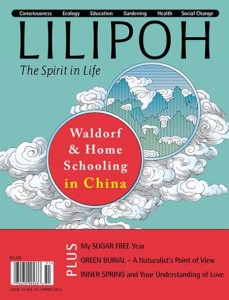Spring 2015, Issue #79: Editor’s Note
 Dear Readers,
Dear Readers,
Many of us in the US are surprised to hear that Waldorf education is being allowed to flourish in China. Rudolf Steiner initiated Waldorf schools as a way to educate children who would have the capacity to bring about positive social change. He wrote: "The need for imagination, a sense of truth, and a feeling of responsibility, these are the three forces which are the very nerve of education." With an imagination, we become creative, independent thinkers (no two imaginations are exactly alike)—how will these creative independent-thinking young adults find their way into a culture that suppresses individuality? How will those with a sense of truth be content where there is government censorship of media and internet? When filled with a feeling of responsibility, we are driven to make a difference in the world. In the face of human rights abuses and environmental pollution gone array, will these Waldorf-educated young people of China begin to stand up to make a difference? In twenty years, how will these thousands of awakened human beings influence their society? Someday we will see how the graduating Waldorf students of China are shaping their social systems as they become the citizens, parents, teachers, and business and political leaders of tomorrow.
In the mean time, our social order here in the West is far from perfect. In fact, the questions asked above also apply to us. While we have freedoms in ways that the Chinese do not—freedom of religion, freedom to speak out against the government, and so on. We can't fall asleep to the social work that still needs to be done. Corporations control our seed supply, GMO labeling has now been shot down in at least three state-wide elections, fracking and the Keystone pipeline threaten our lands, many sectors of society are still plagued with racism and discrimination, and...
Worldwide, we are collectively living different degrees of freedom; there is no ceiling to the potential expansion of our imagination, sense of truth, and feeling of responsibility. A species with so much in common—human beings made of earth, fire, water, and air—we are all consciousness embodied in time and space. Well known consciousness researcher, Stephan Schwartz, opens our eyes to the non-locality of consciousness on page 31, and then, from the macro to the micro, back from a brief hiatus, Culture Pulse editor Leslie Loy shares her deeply personal experiences of motherhood and bearing physical pain (page 54), while Mary Lou Sanelli's whimsical and astute observations on her tropical island writer’s retreat bring us home to what can only be the quintessentially human experience (page 40).
No fixed answers here, only a few clues to help us to pay attention, notice the beauty around us, and remind us of the capacity of the arts to heal, inspire, and educate. Life is so short and there is much to learn and share, and at the end (of this issue), we come to a natural, biodegradable burial as explored by Zalene Corey, board member of the Natural Home Funeral Alliance (page 72).
May your spring be filled with all things new,
Christy Korrow,
Editor, LILIPOH
